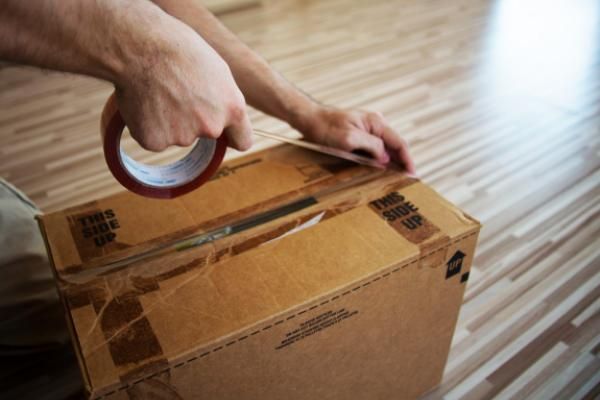



Matt Bergerson, the director of omnichannel fulfillment for retailing co-op REI, has this fantasy: The legendary purveyor of outdoor equipment would establish delivery stations along the Appalachian trail so hikers and walkers that need to replenish their supplies along the way can order them from their smartphones or tablets and receive them at designated pickup points.
The Seattle-based company has no such plan on the table, Bergerson said in a recent interview. Nor is he pushing the C-suite to explore it. Yet even floating such a seemingly far-fetched idea reflects the mindshare captured by e-commerce, its profound impact on American business and its citizens, and how anything is possible in what is becoming “delivery nation.”
<p class="canvas-atom canvas-text Mb(1.0em) Mb(0)–sm Mt(0.8em)–sm" type="text" content="By 2026, about 100 million parcels will be delivered in the U.S. every day, about double the current rate, according to estimates from FedEx Corp. (NYSE: FDX). People can order such everyday stuff as dental floss online and have it delivered in two hours if they want. Executives of supermarket chains who have spent their entire careers operating a brick-and-mortar model are trying to stay ahead of the digital grocery alternative that may upend everything they know. That market sector is expected to ring up $27 billion in annual U.S. sales by 2025. A start-up called ETSI works with global e-commerce buyers and sellers to arrange pick-ups and deliveries, but it has no warehouses or robots. Roadie, another start-up, tenders parcels to non-delivery freelancers who are taking trips in their cars, vans or SUVs, and who happen to be in the same origin-destination market as the packages.” data-reactid=”34″>By 2026, about 100 million parcels will be delivered in the U.S. every day, about double the current rate, according to estimates from FedEx Corp. (NYSE: FDX). People can order such everyday stuff as dental floss online and have it delivered in two hours if they want. Executives of supermarket chains who have spent their entire careers operating a brick-and-mortar model are trying to stay ahead of the digital grocery alternative that may upend everything they know. That market sector is expected to ring up $27 billion in annual U.S. sales by 2025. A start-up called ETSI works with global e-commerce buyers and sellers to arrange pick-ups and deliveries, but it has no warehouses or robots. Roadie, another start-up, tenders parcels to non-delivery freelancers who are taking trips in their cars, vans or SUVs, and who happen to be in the same origin-destination market as the packages.
The exhibit hall at last week’s Home Delivery World annual conference in Philadelphia was packed with a diverse line of products and services that underscored how last-mile residential delivery has come to permeate the daily landscape. Organizers reported today that 2,800 attendees were at the show, a 14-fold increase in just seven years.
There is little mistaking that e-commerce has become synonymous with commerce. E-commerce today accounts for between 9 and 12 percent of all retail sales in the U.S., and even higher when non-digital transactions like fuel purchases are backed out. Projections that the figure could hit 30 to 35 percent within five to seven years are not being scoffed at.
All that demand, however, may not drive profits. Balancing the cost to serve with increasing consumer demands for speed and precision can be a costly exercise, especially as consumers expect and typically receive free shipping on standard parcel orders. Digital is the fastest-growing part of REI’s business, according to Bergerson, who didn’t give details. However, last-mile transaction costs are 5 to 10 percent higher than the cost of a sale in one of its stores, according to Bergerson. To neutralize the headwind, the company pushes its “Buy Online, Pickup in Store” program, which reduces its cost of sale because the product is already in inventory, and increases the chance of additional sales once the customer enters the store, he added. Bergerson said that the ability to influence customer behavior is a key tenet of REI’s strategy, which is helped by the fact that REI’s 150 or so stores are already considered a slice of heaven for people who frequent and love the great outdoors.
Legacy retailers and pure-play e-tailers alike face increasing margin pressure on digital transactions. They either eat some of their margins or, when feasible, raise their selling prices. Even Amazon.com, Inc. has raised prices on “long-tail” items – merchandise that doesn’t sell consistently well – to offset higher shipping and fulfillment costs, according to Sucharita Kodali, vice president and principal analyst at consultancy Forrester Research. “Last-mile delivery is expensive,” she said.
In theory, effective last-mile fulfillment can be distilled into three steps: providing clarity of the order; keeping delivery promises; and being transparent about the order’s status. Hitting those marks, however, can be very tricky. Much of last-mile fulfillment is “omnichannel” in nature, meaning a product can come from any one of multiple locations depending on the cost of shipping and availability of the goods. Then there is the issue of determining the right mode of transport and selecting the proper carrier within the designated mode. According to Bergerson, software that fuses the fulfillment and carrier selection functions is a technology gap that, up to now, has yet to be filled.
Given the lack of information technology seamlessness, it may be no surprise that shipment “exceptions,” defined as an unexpected event that changes a shipment’s delivery status, occur on about 11 percent of all last-mile deliveries, according to information technology provider Convey, which has created a platform that alerts shippers to any delivery problems before the customer has a chance to complain.
<p class="canvas-atom canvas-text Mb(1.0em) Mb(0)–sm Mt(0.8em)–sm" type="text" content="In the fulfillment and delivery of heavy goods, the fastest growing segment of last-mile deliveries, the challenge is different and more acute. On average, 21 percent of all online heavy-goods orders sustain some form of damage during fulfillment and delivery, according to a study by uShip presented at Home Delivery World. That is emblematic, said Robert Foster, who heads business development for Miami-based transport and logistics giant Ryder System, Inc.‘s (NYSE: R) last-mile division, of the reality that most big and bulky items were meant to just be shipped a few miles from store to home, and not hauled hundreds or even thousands of miles.” data-reactid=”45″>In the fulfillment and delivery of heavy goods, the fastest growing segment of last-mile deliveries, the challenge is different and more acute. On average, 21 percent of all online heavy-goods orders sustain some form of damage during fulfillment and delivery, according to a study by uShip presented at Home Delivery World. That is emblematic, said Robert Foster, who heads business development for Miami-based transport and logistics giant Ryder System, Inc.‘s (NYSE: R) last-mile division, of the reality that most big and bulky items were meant to just be shipped a few miles from store to home, and not hauled hundreds or even thousands of miles.
<p class="canvas-atom canvas-text Mb(1.0em) Mb(0)–sm Mt(0.8em)–sm" type="text" content="The battleground for last-mile fulfillment will not be parcels, which is the domain of four very big providers – FedEx, UPS Inc., (NYSE: UPS), Amazon.com. Inc. (NASDAQ: AMZN) and the U.S. Postal Service. Instead, it will be the large-format items like appliances, furniture, bedding and fitness equipment – all merchandise whose deliveries that often involves labor-intensive, complex and value-added "white glove" services such as delivery to a specific room, installation and take-away. Those services, which obviously involve a lot more than simply dropping off a parcel on a doorstep, command high margins relative to parcel, and are likely to see increased demand as ever more SKUs go online. It is common for retailers that curry in big and bulky merchandise to have more goods available on their websites than they do in their physical stores.” data-reactid=”46″>The battleground for last-mile fulfillment will not be parcels, which is the domain of four very big providers – FedEx, UPS Inc., (NYSE: UPS), Amazon.com. Inc. (NASDAQ: AMZN) and the U.S. Postal Service. Instead, it will be the large-format items like appliances, furniture, bedding and fitness equipment – all merchandise whose deliveries that often involves labor-intensive, complex and value-added “white glove” services such as delivery to a specific room, installation and take-away. Those services, which obviously involve a lot more than simply dropping off a parcel on a doorstep, command high margins relative to parcel, and are likely to see increased demand as ever more SKUs go online. It is common for retailers that curry in big and bulky merchandise to have more goods available on their websites than they do in their physical stores.
<p class="canvas-atom canvas-text Mb(1.0em) Mb(0)–sm Mt(0.8em)–sm" type="text" content="Because the barriers to entry are low compared to parcel, the battle for heavy-goods share will be joined by a barrage of newbies and by established less-than-truckload (LTL) and truckload carriers, such as J.B. Hunt Transport Services, Schneider, Inc. (NASDAQ: SNDR) and Werner Enterprises, Inc. (NASDAQ: WERN). Today, many final-mile deliveries are handled by LTL carriers that have complex networks with many moving parts. According to last-mile delivery specialist Innovel, lead times for a final-mile LTL shipment can be as long as two to three weeks.” data-reactid=”47″>Because the barriers to entry are low compared to parcel, the battle for heavy-goods share will be joined by a barrage of newbies and by established less-than-truckload (LTL) and truckload carriers, such as J.B. Hunt Transport Services, Schneider, Inc. (NASDAQ: SNDR) and Werner Enterprises, Inc. (NASDAQ: WERN). Today, many final-mile deliveries are handled by LTL carriers that have complex networks with many moving parts. According to last-mile delivery specialist Innovel, lead times for a final-mile LTL shipment can be as long as two to three weeks.
That may not cut it in the era of the “Amazon effect,” where consumers – especially younger people – have been conditioned to deliveries when and where they want, and for free or close to it. According to the Uship survey, 22 percent of U.S. consumers bought a big and bulky item online in the past year. About 27 percent wanted to schedule two- to four-hour delivery windows, while 16 percent wanted “white glove” service.
For those working in this segment, the opportunity for profitable revenue is great; in fact, that’s what drove many traditional freight players to show up at Home Delivery World. But with opportunity comes risk – damaging a consumer’s shipment, especially inside the home, could cause far more damage to a manufacturer’s or a retailer’s brand than a missed delivery of a box.
Image sourced from Pixabay
<p class="canvas-atom canvas-text Mb(1.0em) Mb(0)–sm Mt(0.8em)–sm" type="text" content="Want more content like this? Click here to Subscribe” data-reactid=”51″>Want more content like this? Click here to Subscribe
<p class="canvas-atom canvas-text Mb(1.0em) Mb(0)–sm Mt(0.8em)–sm" type="text" content="Permalink” data-reactid=”52″>Permalink
<p class="canvas-atom canvas-text Mb(1.0em) Mb(0)–sm Mt(0.8em)–sm" type="text" content="See more from Benzinga” data-reactid=”53″>See more from Benzinga
<p class="canvas-atom canvas-text Mb(1.0em) Mb(0)–sm Mt(0.8em)–sm" type="text" content="© 2019 Benzinga.com. Benzinga does not provide investment advice. All rights reserved.” data-reactid=”58″>© 2019 Benzinga.com. Benzinga does not provide investment advice. All rights reserved.







